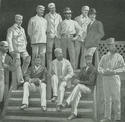 Though many Glasgow sports found their own private space, the Green remained popular for recreation. The increasing Irish influx sustained personal play at football, but it was not a Glasgow spectator passion until much later. Prize fighting and blood sports, notably cock-fighting, declined even further in support and status.
Though many Glasgow sports found their own private space, the Green remained popular for recreation. The increasing Irish influx sustained personal play at football, but it was not a Glasgow spectator passion until much later. Prize fighting and blood sports, notably cock-fighting, declined even further in support and status.
 The new formality in sport meant the emergence of more sporting societies and clubs, now adhering to printed rules for play, with codes for curling appearing in 1804 and bowls in 1848, both being Scottish initiatives. The first bowling club, the Willowbank Club, appeared in the early 1800s, and an archery club followed in 1806, adding to the golf club of 1787. The restricted membership clubs at first used public land but later sought private land. The first Glasgow commercial bowling greens emerged. Horse racing reached a peak of popularity and notoriety in the 1830s and Paisley Races on St James Day became a huge fair with the crowd in 1837 estimated at 110,000.
The new formality in sport meant the emergence of more sporting societies and clubs, now adhering to printed rules for play, with codes for curling appearing in 1804 and bowls in 1848, both being Scottish initiatives. The first bowling club, the Willowbank Club, appeared in the early 1800s, and an archery club followed in 1806, adding to the golf club of 1787. The restricted membership clubs at first used public land but later sought private land. The first Glasgow commercial bowling greens emerged. Horse racing reached a peak of popularity and notoriety in the 1830s and Paisley Races on St James Day became a huge fair with the crowd in 1837 estimated at 110,000.
 However as industrialisation increased in the early 1800s, sport became marginalised. Not only was the working week longer and the old holidays reduced in number, but winter, the time of recreation in the earlier agricultural society, was now as busy a time for the gas-lit factories. War abroad and political unrest at home also affected leisure. The Glasgow Golf Club disbanded and dispersed, leaving only a few non-club golfers on the Green. Decadence in horse racing, led by the gambling aristocracy, spread to other sports. Eventually the new burden of winter work was rewarded by regular summer holidays. When sport revived in the 1860s, summer increasingly became the time for outdoor sport and cricket made its first appearance in Glasgow.
However as industrialisation increased in the early 1800s, sport became marginalised. Not only was the working week longer and the old holidays reduced in number, but winter, the time of recreation in the earlier agricultural society, was now as busy a time for the gas-lit factories. War abroad and political unrest at home also affected leisure. The Glasgow Golf Club disbanded and dispersed, leaving only a few non-club golfers on the Green. Decadence in horse racing, led by the gambling aristocracy, spread to other sports. Eventually the new burden of winter work was rewarded by regular summer holidays. When sport revived in the 1860s, summer increasingly became the time for outdoor sport and cricket made its first appearance in Glasgow.